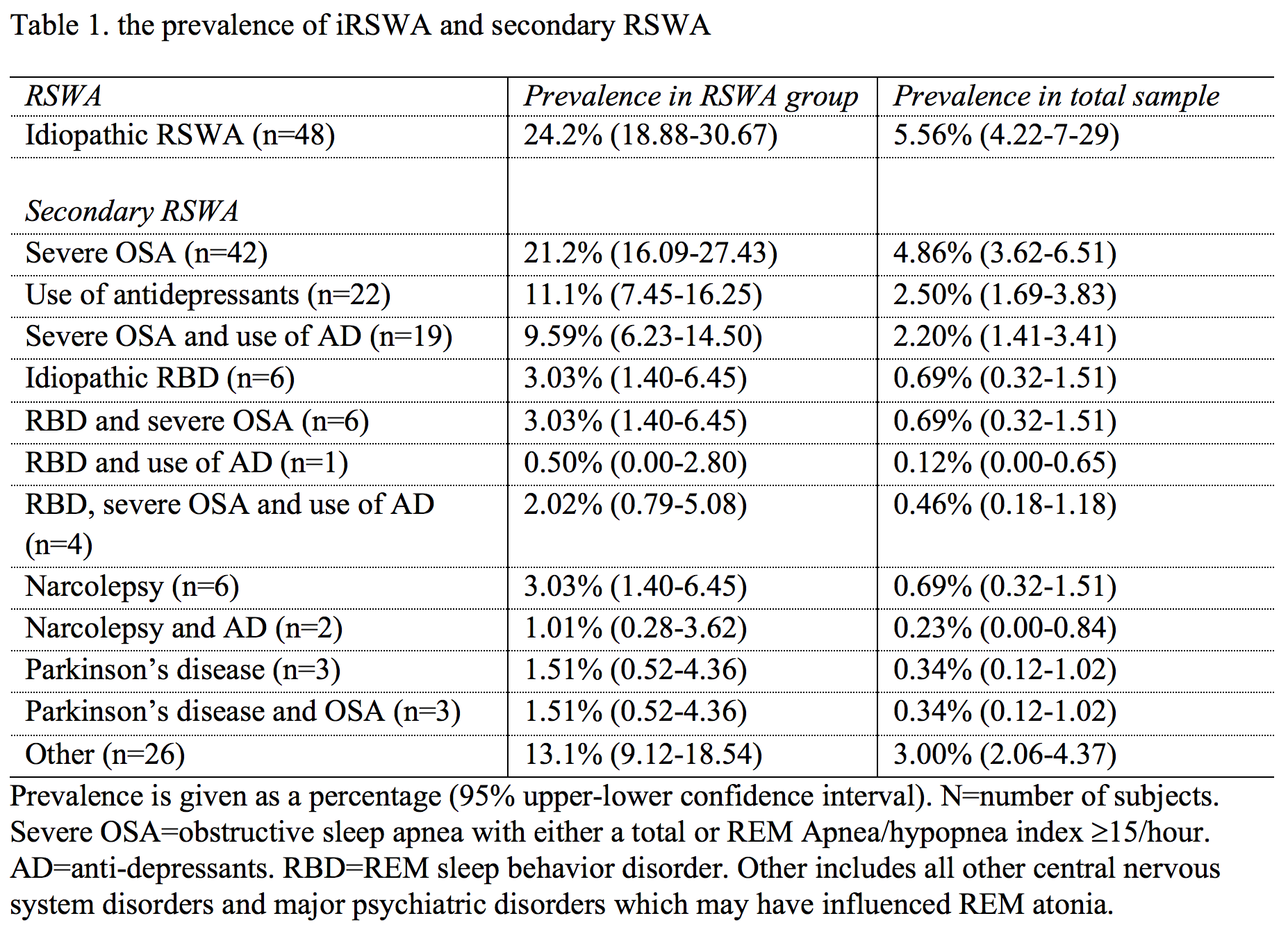Session Information
Date: Sunday, October 7, 2018
Session Title: Restless Legs Syndrome and Other Sleep Disorders
Session Time: 1:45pm-3:15pm
Location: Hall 3FG
Objective: 1. To determine the prevalence of idiopathic and secondary REM sleep without atonia (RSWA). 2. To assess excessive daytime sleepiness and depressive symptoms in idiopathic RSWA patients.
Background: Idiopathic RSWA (iRSWA) without dream enacting behavior is regarded as a prodromal phase of REM sleep behavior disorder and subsequently of an underlying synucleinopathy (e.g. Parkinson’s disease).1 Secondary RSWA, however, is also associated with several other causes, including the use of antidepressants (AD), severe obstructive sleep apnea (OSA), brain stem lesions and narcolepsy. In this study, we have investigated the prevalence of RSWA in a cohort of adult patients in a sleep clinic. We have also examined two additional markers of prodromal Parkinson’s disease2 in iRSWA patients: excessive daytime sleepiness and depressive symptoms.
Methods: We performed a prospective prevalence study of RSWA in our sleep lab from September 2016 until February 2018, combined with an age- and gender-matched case control study with iRSWA subjects. All subjects underwent a classic video polysomnography and a clinical assessment. RSWA and other sleep parameters were scored according to the AASM manual. Excessive daytime sleepiness was assessed with the Epworth Sleepiness Scale (ESS) and depressive symptoms were assessed with the Beck Depression Inventory (BDI). Control subjects had normal REM atonia on polysomnography and no co-morbidities that might have influenced REM atonia. Differences between groups were calculated using a univariate GLM, adjusted for age and gender.
Results: Of the 864 included polysomnographies, 198 were positive for RSWA (prevalence 22% [CI 20.0-25.8]) and 48 for iRSWA (prevalence 5,56% [CI 4.22-7-29], table 1). iRSWA subjects had a mean age of 43.7 (± 13.0) years and 67% were male. Mean ESS scores were 9.93 (± 4.85) for the iRSWA subjects and 7.74 (± 4.87) for the controls (p=0.020). Mean BDI scores were 11.09 (± 7.92) for the iRSWA subjects and 8.65 ( 7.20) for the controls (p=0.105). [table1]
Conclusions: RSWA is a frequent polysomnographic finding and occurs regularly in the context of sleep apnea, antidepressants use or RBD. The prevalence of iRSWA in our cohort is 5,3% and iRSWA subjects reported increased daytime sleepiness. Longitudinal studies are required to investigate the clinical relevance and progression of iRSWA with possible conversion to a synucleinopathy.
References: 1. Högl B, Stefani A, Videnovic A. Idiopathic REM sleep behaviour disorder and neurodegeneration – an update. Nat Rev Neurol. 2018;14:40–55. 2. Berg D, Postuma RB, Adler CH, et al. MDS research criteria for prodromal Parkinson’s disease. Mov Disord. 2015;30:1600–1611.
To cite this abstract in AMA style:
F. Dijkstra, M. Viaene, I. de Volder, D. Crosiers, P. Cras. The prevalence and associated features of REM sleep without atonia [abstract]. Mov Disord. 2018; 33 (suppl 2). https://www.mdsabstracts.org/abstract/the-prevalence-and-associated-features-of-rem-sleep-without-atonia/. Accessed April 26, 2025.« Back to 2018 International Congress
MDS Abstracts - https://www.mdsabstracts.org/abstract/the-prevalence-and-associated-features-of-rem-sleep-without-atonia/

